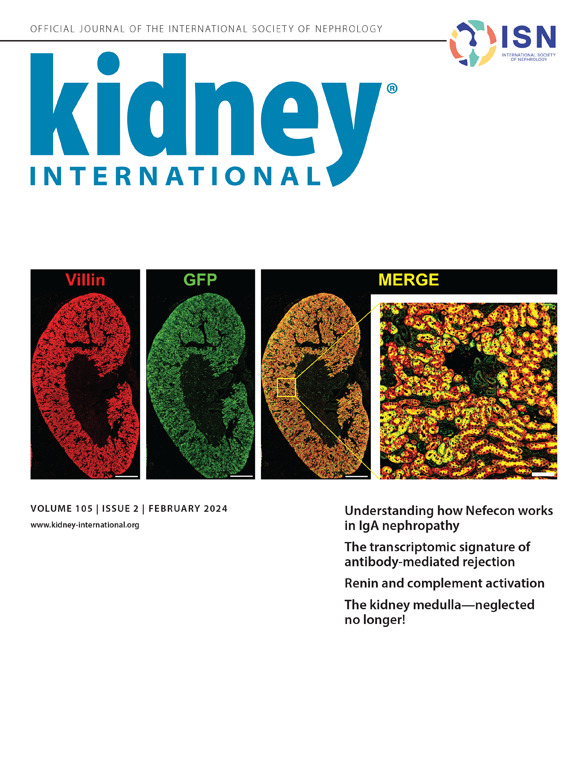Evaluating the risk of cardiovascular events associated with different immunosuppression treatments for glomerular diseases
IF 14.8
1区 医学
Q1 UROLOGY & NEPHROLOGY
引用次数: 0
Abstract
Patients with glomerular disease are at high risk of cardiovascular disease but the contribution of immunosuppression to this risk is unclear. In this retrospective cohort study of 1912 patients (comprised of 759 with IgA nephropathy, 540 with focal segmental glomerulosclerosis, 387 with membranous nephropathy and 226 with minimal change disease) from British Columbia, Canada, we evaluated the association between exposure to specific immunosuppressive medications and a composite outcome including coronary artery, cerebrovascular and peripheral arterial events. Survival models were adjusted for baseline cardiovascular risk factors, type of glomerular disease, estimated glomerular filtration rate (eGFR) and proteinuria over time. During a median follow-up of 6.8 years, 212 patients (11.1%) experienced the primary outcome. Corticosteroid exposure was not significantly associated with the primary outcome after adjusting for cardiovascular risk factors. In fully adjusted models, cumulative calcineurin inhibitor exposure at modest (150-300 defined daily doses [DDD]) and higher (300 or more DDD) doses were associated with a 2-fold higher risk of cardiovascular events (hazard ratio 2.98, 95% confidence interval 1.27-6.95) and (2.78, 1.32-5.84), respectively. A peak daily dose of antimetabolite (azathioprine, mycophenolate mofetil and mycophenolate sodium) of 0.5 or more DDD was associated with higher risk of cardiovascular events after adjustment for baseline risk factors and type of glomerular disease, but not after adjusting for time-varying eGFR and proteinuria (1.70, 0.91-3.20). Each 10 grams of cumulative cyclophosphamide exposure was associated with a 1.5-fold higher risk of cardiovascular events in a fully adjusted model (1.46, 1.22-1.75) Thus, our findings suggest that immunosuppressive therapies used in the treatment of glomerular disease may have different cardiovascular risk profiles, which should be considered when deciding on immunosuppression for individual patients and as a safety endpoint in future clinical trials.

评估肾小球疾病不同免疫抑制疗法引发心血管事件的风险。
肾小球疾病患者罹患心血管疾病的风险很高,但免疫抑制对这一风险的影响尚不清楚。在这项对加拿大不列颠哥伦比亚省 1912 名患者(包括 759 名 IgA 肾病患者、540 名局灶节段性肾小球硬化症患者、387 名膜性肾病患者和 226 名微小病变患者)进行的回顾性队列研究中,我们评估了接触特定免疫抑制药物与包括冠状动脉、脑血管和外周动脉事件在内的综合结果之间的关系。生存模型对基线心血管风险因素、肾小球疾病类型、估计肾小球滤过率(eGFR)和蛋白尿随时间变化的情况进行了调整。在中位随访 6.8 年期间,212 名患者(11.1%)出现了主要结果。调整心血管风险因素后,皮质类固醇暴露与主要结果无明显关联。在完全调整模型中,累积钙神经蛋白抑制剂暴露剂量适中(150-300定义日剂量[DDD])和较高(300或以上DDD)与心血管事件风险分别高出2倍(危险比2.98,95%置信区间1.27-6.95)和(2.78,1.32-5.84)有关。在对基线风险因素和肾小球疾病类型进行调整后,抗代谢药物(硫唑嘌呤、霉酚酸酯和霉酚酸钠)的日峰值剂量达到或超过 0.5 DDD 与心血管事件风险升高有关,但在对随时间变化的 eGFR 和蛋白尿进行调整后则无关(1.70,0.91-3.20)。因此,我们的研究结果表明,用于治疗肾小球疾病的免疫抑制疗法可能具有不同的心血管风险特征,在决定对个别患者进行免疫抑制时,以及在未来的临床试验中将其作为安全性终点时,应考虑到这一点。
本文章由计算机程序翻译,如有差异,请以英文原文为准。
求助全文
约1分钟内获得全文
求助全文
来源期刊

Kidney international
医学-泌尿学与肾脏学
CiteScore
23.30
自引率
3.10%
发文量
490
审稿时长
3-6 weeks
期刊介绍:
Kidney International (KI), the official journal of the International Society of Nephrology, is led by Dr. Pierre Ronco (Paris, France) and stands as one of nephrology's most cited and esteemed publications worldwide.
KI provides exceptional benefits for both readers and authors, featuring highly cited original articles, focused reviews, cutting-edge imaging techniques, and lively discussions on controversial topics.
The journal is dedicated to kidney research, serving researchers, clinical investigators, and practicing nephrologists.
 求助内容:
求助内容: 应助结果提醒方式:
应助结果提醒方式:


